Hamster: a small, furry and adorable creature, too cute to be true, yet these little snowballs bring happiness to our lives just like a kitten or a puppy. These furballs are very useful in the lab, but their cheerful behavior also makes them fit for a docile pet. Before deciding which hamster to keep as your pet, there are a variety of things to consider.
Although similar to other pet rodents like rats, hamsters vary in characteristics and behavior. They have certain needs and specific requirements. This article will inform you all that you ought to know about pet hamsters, starting from their characteristics to a hamster supplies checklist.
Which One To Pet?
Although there are twenty-five different species of hamsters, only a very few are suitable to keep as pets that can be tamed. It is necessary to know this because before purchasing supplies, you must be informed if your hamster likes to live alone or with others. These can be classified into two main types, which are:
The Syrian Hamster/Golden Hamster
The first one on the list is the Syrian hamster, also known as the golden hamster because of their amber color. They are the most popular form of hamster kept as pets. What led to this growing popularity is the fact that they are amiable and friendly once they have been tamed. They are slightly larger than other species which makes them apt for the size of a pet that can be played with. Also, they have to be kept in their own cage separate from others because living with companions often stresses them out.
Dwarf Hamsters and Chinese Hamsters
The second type is the Chinese hamster and dwarf hamsters. Although same in size, they do have different characteristics. Dwarf hamsters include Campbell hamsters and winter white Russian hamsters. These species are smaller and significantly faster than Syrian hamsters, but they are playful pets and a treat to watch. However, unlike Syrian hamsters, dwarf hamsters can be kept in groups and bunches, but this is always not the case for Chinese hamsters. Chinese hamsters may or may not be acquainted with life with partners.
Check out our article on: How To Tame a Hamster
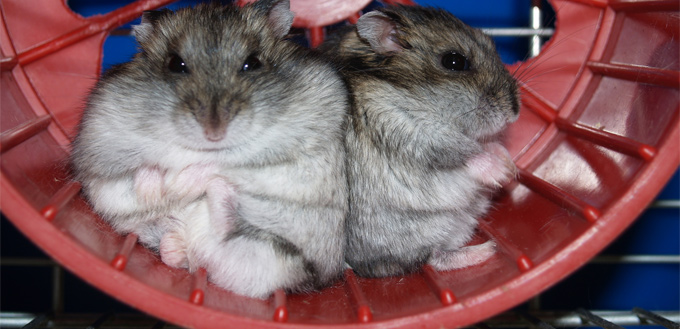
Hamster Habitats
In the wild, hamsters normally live in warm and dry places. They love to dig and make a burrow thus they live on the soil. They also like to explore around a lot. At your home, you can make or buy a habitat for your pet hamster that closely represents their natural habitats and where it will be comfortable to live in. The closer it is to their natural habitat, the easier it will be for the little creature to adjust. There are many things to consider while choosing the perfect habitat for your little furry friend. These are the essential things you need to know about your hamster’s habitat:
The Cage
There are many different types of cages you can choose from. They can be completely simple like the conventional wire cage, or complex with tubes and tunnels such as the plastic tube cage. The type of cage you choose depends on several factors such as your choice of a hamster, ease of cleaning, storage space at your house, etc. Let’s have a look at the different types of cages available at the market.
1. Wire Cage
The most typical is the wire cage. Wire cages are the classic bar cages made of wires and a plastic floor that can be detached for cleaning. It is plain and simple. They may come with accessories such as a hamster wheel, drinking bottle and food dish. However, you should be careful about the space between the wires because if it is too small then your hamster’s paws may get stuck to it, too big- your hamster can squeeze out and escape! Here are a few pros and cons for wire cages:
Pros:
- Easy to clean and allows for plenty of ventilation.
- Allows for activity for your hamster like climbing.
- Versatile shape means you can add accessories.
- Portable structure makes it easy to carry around and place anywhere.
- Lots of varieties are available including multi-storey.
- Usually cheaper than other cages that are available in the market.
Cons:
- The gaps between wires can be a source of escape and can hurt the hamster’s paws if they get stuck.
- Hamsters tend to chew on the wires which will result in damaging their teeth.
- If the sliding door gets loose, your hamster will be able to open it and flee.
- If you have other pets, they may disturb the hamster through the wire gaps.
2. Plastic Tube Cage
Plastic tube cages took the market by storm when they were first introduced. They are complex and well designed. They include many tubes and accessories that are built in such as wheels and lookouts. It is like a fun playground for your little pet hamster. The pros and cons of plastic tube cages include:
Pros:
- Have many sections and attachments which make it look attractive and appealing to the eye.
- Literally a playground for your pet hamster that will keep it moving and do an ample amount of exercise.
- Will keep your hamster entertained during most of its active hours and it will not get bored.
- Usually has built-in necessities such as hamster wheel and food plate.
Cons:
- Difficult to clean and maintain due to its many nooks and crannies.
- Does not provide proper ventilation which your hamster desperately requires.
- There is a chance of the hamster getting stuck inside the tubes.
- Price is more on the higher end.
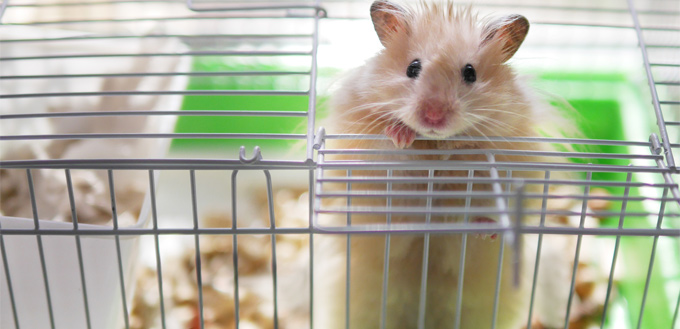
3. Aquarium/ Box Cage
Another option for a good habitat for your hamster is the aquarium or box cage. These can be made of plastic or glass. They are nothing fancy, just a box-shaped house for your hamster with an open top. They have certain pros and cons, which are listed below:
Pros:
- Plenty of floor space which allows for lots of room for your hamster to play in.
- You can decorate and accessorize it the way you want to.
- Glass cages are technically escaped proof and allow you to see precisely what your hamster is up to.
- Easy to clean and can store many hamsters in one place.
Cons:
- No room for ventilation which will lead to condensation and creation of a foul stench from urine.
- Hamsters may feel isolated from the outside world as they will be enclosed in a box and cannot contact the outside world.
- Price tends to be more on the expensive side.
- Additional costs will be incurred for added accessories to turn the box into livable conditions.
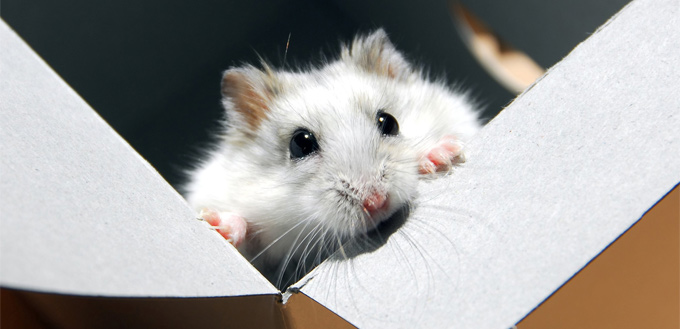
4. Cage Aquarium Hybrid
A more modern form of the cage is the cage-aquarium hybrid. If you are investing in the home of your hamster, you should invest in the best one because it will live there for its small lifespan. The hybrid cage is a two-story house for a hamster. On the top level is a horizontal wired cage and accessories to play with such as wheels and bridges. A wide plastic tube connects this to the bottom story which is filled with a soft material such as soil or cotton, where they can urinate. Some pros and cons of this hamster habitat are:
Pros:
- The best one to choose if you are confused between box cages and wire cages.
- This looks like a modish piece of furniture at your house, placed anywhere.
- May come with a drawer to keep all your hamster supplies securely in one place.
- Provides built-in appendages that will keep your hamster playful and active.
Cons:
- It is hard to clean and maintain due to its multi-levels and platforms.
- Its bulky size does not make it portable and painless to carry around.
- The price is on the expensive end so make your investment thoughtfully.
5. Carrier Cage
If you are taking your little friend along with you, then a portable hamster carrier cage is something you should have among your possessions. These are wire cages with a handle on the top that allows you to carry it around like a travel bag. Hamsters have the risk of getting anxious during trips if not taken care of properly, thus you must choose the travel cage wisely.
Pros:
- Portable and easy to carry around during trips.
- A fun play box for your pet hamster so it will not be irritated if the trip is long.
- You can carry along all other necessities such as food bowl and flask in it.
- Cheaper than other cages and a great need if you take along your pet in your travels.
- Provides plenty of ventilation and comes with built-in accessories and toys.
Cons:
- Added hassle of cleaning and maintaining.
- Hectic duty to transfer things from this cage to that.
- The hamster may not be prepared for a sudden change in habitat and can take time to adjust.
- Will be a waste of money if you are not a frequent traveler.
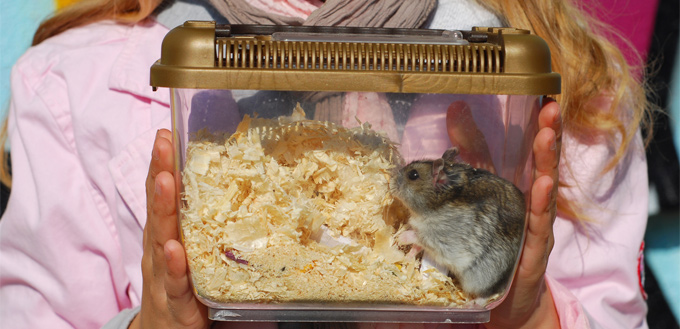
Size of the Cage
This will vastly depend on the type of hamster you choose to pet. Syrian or golden hamsters are large and unsociable. They prefer to live alone and get anxious with a partner, they may also attack them. Given their size, it is advisable to get a cage of at least 60cm by 30cm of floor space and 30cm in height. Hamsters also like to move around a lot and exercise, so a big cage filled with accessories is crucial for their survival.
As for a dwarf or Chinese hamster, a closed aquarium or a very tightly fitted cage is desirable. This is because these species are only two inches long and given their wiggly bodies, they can easily squeeze out of a cage. Their living space should stretch at least 40cm by 20cm in floor area and 20cm high. Chinese and dwarf hamsters are able to live in groups and bunches, thus the area should be bigger if you are planning to contain more than one pet hamster.
Alignment of the Cage
All wire hamster cages should be horizontally aligned and not vertically. This is because; hamsters are good at climbing up but not an expert in coming down. So it is the owner’s duty to ensure they are able to easily climb down as well. You should also keep in mind that the cage or aquarium should not be very high because there is a risk of them falling off and hurting themselves. Multi-level cages are usually high but they have built-in facilities and structure that help secure your hamster in place and lower the risk of falling from an unsafe height.
Material of the Cage
The cage should not be made of wood or soft plastic as hamsters are excellent chewers and will start chewing their own homes! A homemade of wood will also absorb urine and will get stinky easily. A wooden home is also hard to clean as contact with water will make it damp and soft. Thus it is best to avoid wooden habitats for your hamster.
The floor of the cage is usually detachable for easy cleaning. You should cover this tray with a soft material so that they do not scratch and destroy it. Cardboards, newspapers and kitchen papers can be used to cover the floor. A big part of the floor should consist of soil as they are habituated to dig a burrow for sleeping in. It can also be used for them to play and dig around. A more elaborate discussion follows later in the article about what type of materials are safe to use and which ones to avoid for this purpose.
Environment
- Weather and Temperature
At your home, hamsters should be kept away from extreme heat such as stoves, fireplaces and direct sunlight. Conditions such as these can make them fall ill and become irritated and will also hamper their daily activities. It will negatively affect their normal routine and lifestyle. Avoid the kitchen and garage as they may be too hot or cold. The ideal temperature suitable for your hamster is approximately between 65 to 75 degrees Fahrenheit; if it is too cold then they will hibernate and if t is too hot they may die.
- Surrounding
Hamsters prefer to live in soiled or sandy areas due to their habit of digging a burrow. Where they like to live vastly depends on their place of origination. Hamsters also love to explore a lot. It is recommended to let them out of their cage once daily to explore around in order to keep them happy and lively. But bear in mind that this expedition must be supervised. Hamsters have very poor eyesight and track their ways using their efficient olfactory organs. Some hamsters are also great runners, especially the small ones. If let loose alone, you might lose your pet forever!
- Location of the Cage
It is good to place the cage in a quiet place, away from the daily noise and even electronics that produce ultrasound. Hamsters have an excellent hearing ability and hear a lot of sounds which humans cannot. As they are sleeping during the day, these sounds will disturb and annoy them and they will become grumpy. You should also maintain even temperature and lighting throughout the day and night.
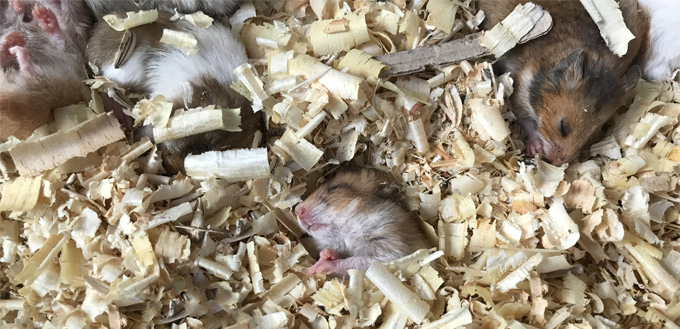
Components of the Cage
Hamsters are very organized and clean by nature. In the wild, they will make different sections for sleep, storage, and toilet and will likely do the same in the habitat you provide them with. To give your hamster the best out of their concise space, it is quintessential to provide them with all the necessities they require in it. If bored, they can become aggravated and this may result in aggressive behavior. There are many things you can include for their entertainment. Let us begin by discussing the necessities:
Bedding
Your hamster’s comfort directly reflects its health and happiness. If you are able to provide for it a comfortable lifestyle, it may live longer. The foremost important thing for a good quality lifestyle is appropriate bedding. As habituated by digging and living in a burrow, the bedding for your hamster must replicate these somehow. Below are some guidelines for your choice of bedding:
- The bedding of your hamster has two layers: the substrate and the nest. The substrate is the wider and bottom part of the bedding while the nest is the top part where they curl up and sleep.
- The bedding you provide must be safe and clean for your hamster. You should choose the material of the substrate bedding very carefully. Plant-based paper fibers, hemp, wood pulp, and wood shavings are good options. Aspen is one of the very few safe woods available to use and you must avoid pine woods and cedar wood as they contain allergens which is harmful to your hamster’s health.
- The bedding should be fragrance-free and dust free. Some scented beddings may make your hamster uncomfortable and dusty materials used for beddings will make your hamster sneeze and irritable.
- The bedding must efficiently soak in liquid and should be nontoxic. It should be able to extinguish foul odors.
- You should be extra cautious and make sure the bedding is free of any sort of insects or mites. You can do so by putting the new bedding in the freezer for two days and then let it defrost naturally before placing it into your hamster cage.
- The nest bedding should be soft so that your little pet can sleep in it comfortably. Tissue paper-based materials such as kitchen paper and newspaper are good choices for this.
- The length of the bedding should be at least six centimeters deep. You can add more if you want to.
Hamster Wheels
Running and exercising regularly is a necessity for all hamsters. They are required to do so in order to function properly. In the wild, they get the opportunity to run around long lengths in search of food, but while being a pet in your home, their scope is limited. Thus the wheel is a necessity for their daily activity and adequate fitness. Some things to keep in mind while picking the wheel are:
- The surface of the wheel should be solid and not made of wires, as your hamster’s little toes can get tangled in them. Metal wheels are sturdier than plastic wheels and will last longer.
- The wheel must be made of a non-slippery and non-toxic material to ensure the safety for your hamster.
- The size of your pet hamster will determine the size of the wheel. The wheel should not be too small that it arches the body of the hamster while running; neither should it be too big that your little pet has trouble moving in it. For a small hamster such as dwarf hamsters, a wheel of six inches is ideal, while for larger versions such as the Syrian hamster, an eight-inch wheel is suitable.
- Before making your purchase, you should test how much noise the wheel is making. Hamsters are a nocturnal creature, which means that their most active hours are during the night. You do not want their active hours to disturb your sleeping hours!
- Wodent wheel, silent spinner and comfort wheel are the most common types of wheel available for purchase which are extensively used by pet owners.
Cage Accessories
Apart from the basic necessities, your hamster also requires recreation. Supplying it with these things will keep them happy. There are many things you can add to your hamster cages, such as toys and hamster house. Let us look at each briefly:
- Hamster House/ Hide Box: a house or a hide box is a private enclosure for your hamster. Hamsters are very organized and usually mark separate spots as separate “rooms”. The hide box can work as a sleeping spot for your hamster. Soft plastic and softwood can be chewed thus avoid these materials while selecting the hamster house.
- Hamster Toys: other than the wheel and hide box, you can provide your hamster with additional accessories and toys. A softball, a metal ladder, and small replica wooden trees are good options. You can also create your DIY toys such as an empty kitchen paper roll or carve out an opening out of a coconut shell. These projects are fun to create and if you are not willing to put in the effort, there are lots of toys available in supermarkets, pet stores and even online.
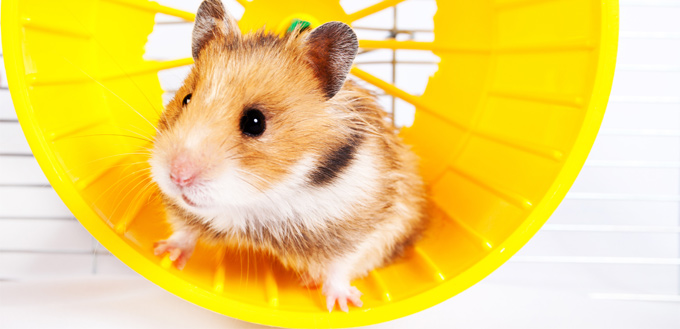
Hamster Health:
Being the owner of your pet, it is your responsibility and duty to make sure they are getting sufficient nutrition. You must have full knowledge about what to feed your hamster and what not to, which is healthy and safe to consume and which should be avoided. This section will explain what you should feed your hamster and what are the things needed while doing so.
- Hamster Food: A unique characteristic of the hamster is their pouch cheeks. They are shaped like pouches to carry food around because that is hard to find in the wild. In the wild, they survive by eating grass, seeds and At home, you can offer it to eat a bounty of tasty and nutritious treats. Hamsters can be fed both stores bought treats and fresh fruits and vegetables. For store-bought treats, muesli and pellets are great options. But be careful about the sugar content. Too much sugar is bad for your hamster’s diet. Hamsters can also feed on a variety of fruits and vegetables. Some of the top picks are apple, banana, pear, broccoli, peas, sprouts, cauliflower, peach, chicory and carrot. You can also give your hamster occasional treats such as a piece of boiled egg or tofu, both of which are great sources of protein. Some foods that you should avoid are eggplant, garlic, leeks, rhubarb, onions, and citrus fruits.
While feeding your hamster, it is important to keep the quantity in mind. Surprisingly, both Syrian and dwarf hamsters require the same amount of food as dwarf hamsters have a faster metabolism. Hamsters have a habit of storing food but since they do not overeat thus do not be tempted to provide them unnecessarily with abundant food. A chunk of fruit and vegetable will be sufficient for a meal. It is also important to provide fresh food every time. Food is best served on a food bowl or tray. This will keep both the food and habitat clean. Hamsters are clever rodents and will recognize it as their eating spot. Make sure to wash it properly and regularly.
- Water Bottles: It is necessary to provide your hamster with plenty of water during its active hours so that they are not dehydrated while doing activities. Hamster water bottles are a better tool for proving the fluid than bowls. A water bottle will keep the water secured and prevent it from leaking or spilling over. The typical design for a water bottle is a sprout that faces downward with a tap that is easy to open and close. Glass and metal are suitable materials for the water bottle. For a glass tank or aquarium, you will need a water bottle holder or a water bottle stands along with the bottle. Once again, the size of your hamster will also determine the size of your choice of water.
You should also be careful about changing the water daily and cleaning it correctly. A cleaning brush designed to clean water bottles will come handy in this case. It is recommended to clean the water bottle with hot water and detergent to disinfect it. Be sure to place it away from direct sunlight as this will cause algae to form.
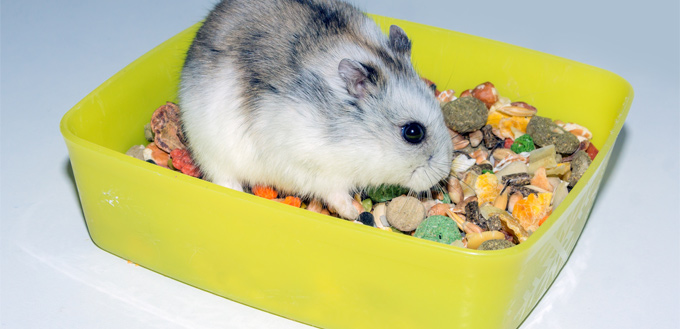
Hamster Hygiene
- Clean Habitat: Your hamster’s hygiene is reflected by its appearance. Thus, in order to keep it healthy, it is mandatory to keep both the hamster and its cage clean. You should wash the cage with antibacterial soap and water at least once a week. You ought to keep a separate brush and wipes only for the purpose of cleaning the cage. You can use liquid soaps and odor absorbing pebbles to get rid of any foul stench coming from the cage.
- Water bath: Hamsters are naturally a very clean animal and do not require water baths. Each living thing has their unique set of needs and hamsters have evolved in such a way that they are able to keep themselves clean without the use of water. Giving it a water bath increases its risk of illnesses such as a runny nose and constant sneezing as they have a frail health. Also, by doing so you will be washing away important compounds from their furs that they need.
- Sand Bath: What hamsters actually need to keep themselves clean is a sandbox. Place a tray of dust and allergen free sand in their cage once a while. They will roll over it to get rid of any dirt or unwanted materials on their body. You can do the same with a soil box. Hamsters fix a spot or two to relieve themselves and if you provide a specific plate for them, they will recognize it as the place to do so. This will also provide easy cleaning as you can easily scoop up the contaminated soil every morning and replace it with a fresh
So, here’s your guide to the complete list of hamster supplies that you may want to buy. Caring for a pet may be tricky and time-consuming but with right supplies and knowledge, you can be a connoisseur in no time.
Related Post: How Much Do Hamsters Cost?







I would like to note that this article contains a lot of misinformation. Firstly, I am frustrated on how you say that dwarf hamsters can live in small groups. Any experienced hamster owner knows that you shouldn’t keep pairs, much less groups, unless you are looking forward to waking up to find one or more of your hamsters injured, maimed, or dead. You also state that connectable cages are a “playground” for hamsters. A playground would be a large (over 900 square inches of unbroken floorspace ) enclosure with lots of enrichment, including over 8 inches of bedding, a 10 inch wheel, lots of hideouts, tunnels, and more. Please, house your hamster alone in a large enclosure with a large wheel and lots of enrichment. A small cage is quite literally animal cruelty, as you are being cruel to the animal that you are trapping in it. Thank you for reading!